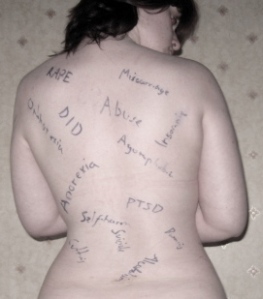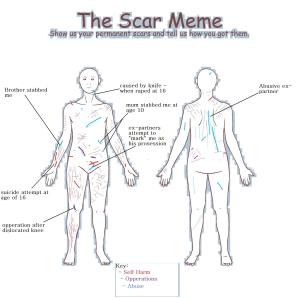[tweetmeme source=”Life_With_DID”]
Self-harm is generally defined as acting to deliberately injure yourself physically. The exact form of harm varies, some forms being invisible or don’t leave a wound, whereas others are visible, damaging the skin or other outer area. These visible forms (especially cutting) are seen as a more common form, but due to the secrecy held by many self-harmers regarding the activity and their reluctance to seek medical attention make it difficult to judge the real scale of self-harm.
Some people always harm using the same method, others use different methods based on what is available at the time or what will be easiest to hide. Some people who engage in self-harm do so only on specific parts of the body, others will vary in what area they harm, though many do say that they favour one area, failing to get the same degree of relief/comfort/pain/etc from other areas.
One very important thing to remember when discussing self-harm is the difference between acts with the intention of causing harm to the body and acts with the intention of ending ones life. In some ways these two actions could be seen as opposite to one another, with suicidal actions aiming to escape from life by ending it, whereas self-harm is an attempt to cope with life with the aim of continuing it. However, it is important to be aware that self-harm is often very closely linked to suicidal thoughts and attempts. Statistically those who self harm are many times more likely to attempt suicide than those who do not. Even those who are not suicidal may risk their life unintentionally if their harming becomes serious. Most teenagers say they harm in an attempt to express distress and escape difficult situations, but every year some lose their lives, even though this was not their aim.
How common is self-harm?
As with many emotional and mental health issues, where so many keep their suffering a secret, it can be very hard to gain accurate figures. Another important consideration is that often even the friends and family of the person will be unaware of the self-harm, to such a degree is this secrecy.. What we do know though is that in the UK alone self-harm is responsible for over 150000 admissions to A&E a year, and this is only counting those who admit to their wounds being self inflicted. Research conducted anomalously through charities and support groups also indicate that only about 15% of people who self-harm will seek medical attention for their wounds, so this 150000 really can only be seen as the tip of the ice-berg.
People of all ages and from all backgrounds may at some time engage in self-harm, though it is most commonly seen among adolescents. The NICE report into self harm indicates that the average age changes of adolescence have been removed, but for many the issue will continue into adulthood. Self harm seems to be more common in females than in males overall, though in fact more boys than girls under the age of 10 are admitted to hospital due to self-harm. In adolescence, girls may be around two or four times likely than boys harm in different ways and may be more likely to cover it up as the result of an accident or a fight. Self harm also occurs in adults, and there is some evidence that adults who self harm are at greater risk of serious consequences such as suicide attempts or hospital admission.
One group of adults who seem particularly vulnerable to self harm are prisoners, over half of female prisoners on remand say that they have self-harmed at some point in their lives. This may be because some of the common triggers of self-harm are more common in those who are vulnerable to committing crimes than in the general population, the actual prison environment may also serve to cause self-harm as prisoners are likely to know others who self-harm, may be discouraged from openly expressing emotion, and are often unlikely to gain access to support for mental health issues.
Is it worth it?
This is a sensitive area, but it needs to be discussed I think. I started self-harming at the age of 6, I am now 23, in that time I have had a bit of a love/hate relationship with the act. Self-harm doesn’t just cause instant damage; there can be long-term effects, as well.
Each method of self-harm has it’s own variety of physical long-term risks from scaring to internal damage. Cutting is seen as the most common form of self harm, this has many risks not only scarring – cutting your skin can have more serious consequences. If you are cutting your wrist, you’re not very far away from the mechanics of the inside of your arm, every year lots of people injure tendons, nerves, blood vessels and muscles. And although some of these can be repaired, if you cut a major nerve in your wrist you can be left with permanent weakness or numbness in your hand. Burning is similar to cutting in that it causes damage to the skin and can leave a scar, but burns are far more likely to become infected which creates it’s own set of problems. Chemical burns, however, can cause massive destruction and people can even lose limbs. Potentially it can be life threatening.
Because of the fragility of the head and brain, repeatedly banging your head against a wall or another object could do long-term damage. While there hasn’t been particular research into head banging as a form of self-harm, researchers have investigated whether footballers are at risk of brain damage through heading footballs and in 2002, a coroner ruled that Jeff Astle, a former England World Cup player, died from a brain disease that was caused by constantly heading footballs. Meanwhile, research from America found that the greater the number of times a ball had been headed, the more that reaction time and flexibility of thinking was reduced.
An overdose of any drug is not healthy for your body, and the effects will vary depending on what you took, and the quantity. The main organs affected by paracetamol overdoses are your liver and kidneys. Assuming the initial effects are treated, there is then a chance that long-term organ damage can occur.
There are other forms of self-harm too which are equally dangerous, but these are less common so I will not discuss them here.
The effects of self-harm those are not just physical. The act and the resulting scars make you feel like an outcast, people judge you for what you have done, you feel guilty and ashamed which causes a decrease in self-esteme and people to retreat from society and from the help and support that is out there. When a person has relied on self-harm as a form of coping for a long period of time it also becomes their main coping method, when things feel too much the mind automatically goes to self-harm any and all alternative methods of coping are thrust from the mind until it feels as if self-harm is the only way to feel better. Due to this recovery from self-harm requires not only being able to let go of an act which you have come to rely upon but also relearning other ways to cope and to deal with things which occur in life. This is a long and difficult process.
Self harm is a legitamate coping mechanism, but there are better ones out there. When you self-harm you get a temporary release, but once that’s faded the problem is still there with the added issue of isolation, shame and possibly a hospital visit. In short, no, self-harm is not worth it, but for many it has become their sole method to getting through life. So no, self-harm is not a good thing, it’s not something that should be celebrated nor taken lightly, but it also should not be ridiculed and those who suffer and struggle with it should not be shuned for the act. People need support and understanding not isolation and insults.



















